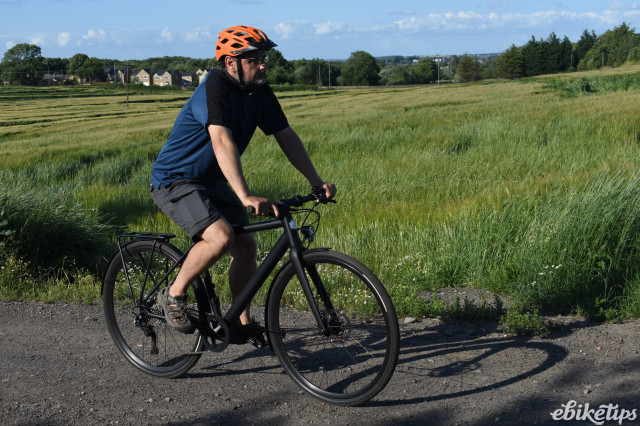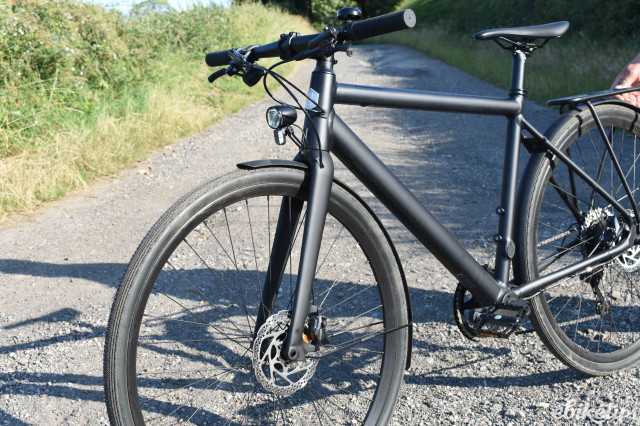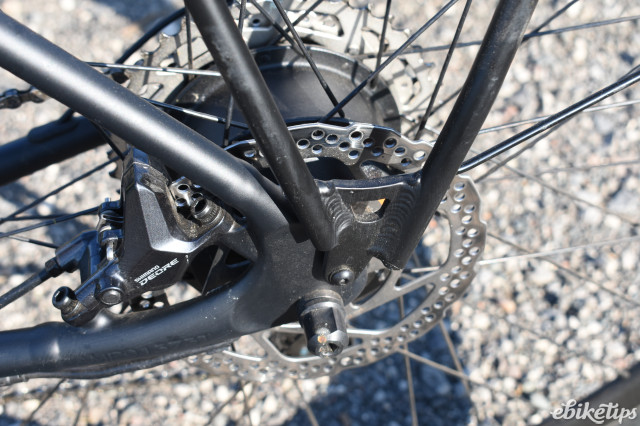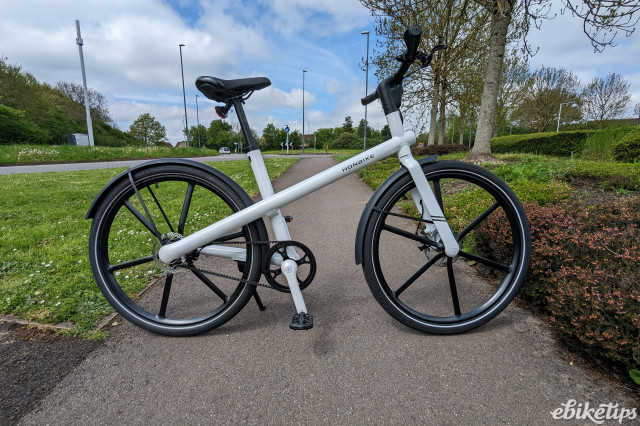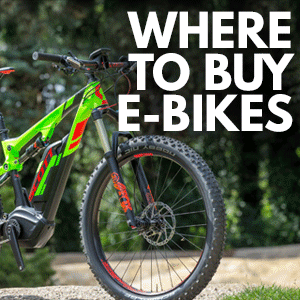Review: Ampler Curt 11 speed
Overview
- Lightweight
- Good range from the modest-sized battery
- Simple to use app
- Fiddly top tube button control
- Pricey for a hub motored e-bike
The Ampler Curt is a lightweight electric gravel-styled bike that doubles as a city runabout. It is the flagship model from the Estonian company who have made a name for themselves with lightweight single speed city e-bikes.
Ampler have added an 11-speed high quality derailleur setup to this particular variant. Along with its full complement of equipment (bar a kickstand) plus gravel capable tyres, this has resulted in a lightweight commuting and 'touring lite' e-bike.
Add in a frame-hidden GPS tracking module and you have a great looking combination of subtle but meaningful electric assistance and high-tech in a sleek package that doesn't immediately scream e-bike.
Ampler Curt spec
At first glance the Ampler Curt is very similar to the Raleigh Trace we've already had a look at. There is a lightweight alloy frame and carbon fork, integrated battery that is not removable for charging, hardwired lights, gravel capable tyres, tough mudguards and a rear rack.
The Curt has the edge in a few areas though: a larger battery (336Wh vs 250Wh) and - in our opinion - a superior ride experience, more on which below. This is possibly due to the torque sensing of the Ampler, which the Raleigh lacks. The Trace does however steal the show in terms of weight (14.5kg vs 16.3kg) and price (£2,199 vs £3,210 - though both were discounted at the time of writing).
Unlike the Raleigh, the Curt also comes in a single-speed option with a wonderfully clean and low maintenance belt drive that would make a fast and sleek city runabout if your local hills aren't too demanding.
It's definitely one of those e-bikes it's hard to immediately identify as being motor assisted as the rear hub motor pretty much hides behind the gears and brake disc and there are nicely integrated cable runs. It lacks the super-smooth polished welds of some other e-bikes, but the matt black frame itself still looks sleek and very well made (gross weight rating is an impressive 155kg).
I liked the fact the cable runs to the rear of the bike enter through the headtube rather than the handlebar stem, making it a relatively simple matter to change the stem or handlebar for ones that would give a more upright riding position if you really want to do that (though if you can live with the 9 gears rather than 11, then Ampler's Stout and Stellar models give more upright riding positions and benefit from the same motor system that is used across Ampler's whole range).
The bespoke rear rack on the Curt has the advantage that it will accommodate a rack top bag, but the disadvantage that it would obscure the seatpost integrated LightSKIN rear lights. Touring potential is also enhanced by the bottle cage mounting points and a 3 amp charger that means a full charge can be achieved in just 2.5 hours. Half a battery charge can be achieved in the time it takes for a lazy lunch stop.
Another plus for the Curt over the Raleigh Trace is the frame-hidden module that gives Bluetooth, GSM and GPS wireless connectivity. The top tube display shows if you are connected to the GSM and GPS networks at any given moment and it also neatly displays battery capacity via a 'battery bar' icon, plus estimated range.
This display itself appeared pretty accurate and was helpful in use, but as the main control button is under the top tube, changing assist levels (of which there are two) means taking a hand off the handlebars (a similarity with the Raleigh) and I'm not a fan of this. I find the more usual approach of having the power controls on the handlebars by your thumb far easier to use.
Whilst there is an accompanying app which I liked (more on that in the Performance section) the Curt lacks USB charging, which is a pity as it's such as useful feature. The equipment package is completed by a powerful B&M IQ-XS front light and that LightSKIN LED seatpost integrated rear array - highly visible if not obscured by a rack top bag. I felt the only real omission was a kickstand.
Ampler Curt performance
The Curt comes in three frame sizes (small, medium and large), the small being about right for my 5ft8in frame. It's quite a racy posture and together with that stiff frame and carbon fork combo, it's better suited to smoother off-road surfaces than really bumpy ones.
As soon as I pressed on the pedals I noticed the precise and smooth pedal torque-sensing motor control system and it works well with the quick-changing and wide ranging 11-speed Shimano Deore gearing.
Whilst the motor didn't break any records on our extended hill climb with a constant gradient of around 5-10% it actually did reasonably well on the ultra-steep bike path challenge. This suggests it has a good bit of low speed torque and slightly more moderate assistance at higher speeds. This seems the right way round as it gives you the motor power when you are most likely to need it.
Sure, you won't go up hills as quickly as you will on a Bosch bike, but that's not to say the Curt isn't a capable hill climber. Heavier Bosch bikes will also be more of a struggle to lift up stairs, onto a bike rack or over an off-road obstacle, like the dreaded 'horse stiles' found on many bridleways.
After a fair few rides both with and without a load on the sturdy rear rack, I came up with a range estimate of 25-40 miles from a single charge - with the usual 'range depends on a huge number of factors' provisos. (To cite just one, I weigh around 75kg.)
My local riding area is full of hills, so it certainly gave the Curt a good workout and I was never struggling to crest any summits or hugely out of breath. I just felt I had had a good but not overly taxing workout, which is arguably an advantage of lightweight e-bikes like the Curt with a motor system at the more modest end of the e-bike power spectrum - they let you do a bit more of the work.
The 40mm wide Panaracer Gravelking semi-slick tryes rolled smoothly and quickly on and off road whilst the Shimano M6100 hydraulic disc brakes were as effective as you would expect and the B&M IQ-XS front LED gave powerful and well controlled illumination even on unlit roads.
The Ampler app is not as feature-packed as many, but in this case its simplicity is part of its appeal. The 'home screen' shows speedometer, battery % capacity and estimated mileage range - all seemed pretty accurate and helpful.
I also found the ability to tweak the assist levels very useful. I adjusted the power available in levels one of two modestly downwards, so I felt I was able to use the motor effectively in many situations without wasting any power.
There is a lock function which effectively locks the bike in the power-off mode but it doesn't feature an alarm or motor lock which would have been helpful anti-theft features to add (though of course a good lock and sensble parking practices are always the best initial lines of defence). Ampler say the system has movement notifications, but I couldn't get these to work. Perhaps I hadn't enabled them, but if so, it wasn't obvious how to do this. There is a map screen which allows you to always check on the location of the bike however, which could act both as reassurance or perhaps as useful intel for the police if the worst happens and the bike is stolen. The location may take a little time to update but it generally does update eventually.
A final point to note is that you buy direct from Ampler and deal with them for any after sales issues. (All Ampler e-bikes come with a two year warranty.) The upside is that they are a longstanding company with a good reputation and where there have been problems in the past they have been totally and refreshingly transparent about them. Also of course they will know the bikes inside out. The potential downside is that, as yet, they don't have any of the bricks and mortar service centres that they have in some contiental European countries such as the Netherlands.
Ampler Curt summary
Whilst there are cheaper, lower-tech, hub motored e-bikes out there similar to the Curt - like the afrorementioned Raleigh Trace or the Juicy Ticket, the relatively high price of the Curt means it will increasingly be up against more powerful, £3K-plus lightweight mid-drives, employing systems like the Fazua Ride 60, TQ-HPR 50 and now the Bosch Performance Line SX.
As it stands, the Ampler Curt is a great and pretty lightweight option, so it will be interesting to see just how heavy the new lighter mid-drives turn out to be.
Canyon have a range of similar design bikes in the Commuter ON range where the 'more power = more weight' equation still holds, the Commuter ON range being around 1.5-2kg heavier.
In summary, the Ampler Curt is definitely one to add to your list if you are looking for a lightweight, fast-riding and efficient commuter e-bike that can double as a gravel bike you could use for bikepacking. The battery not being removable for charging may be a problem for some, but Ampler must have figured that having such a light transportable e-bike may make that less of a negative. Overall it's a fun, fast, lightweight ride with the high tech it incorporates being suitably minimalist but functional too - much like the rest of the bike.
1 comments
Given the demise of Van Moof whilst all this integrated tech looks good, what stops the bike turning into a doorstop if/when Ampler cease trading?



















